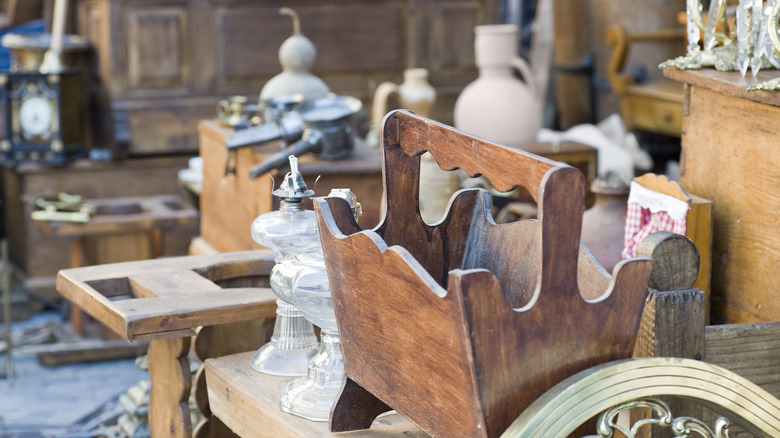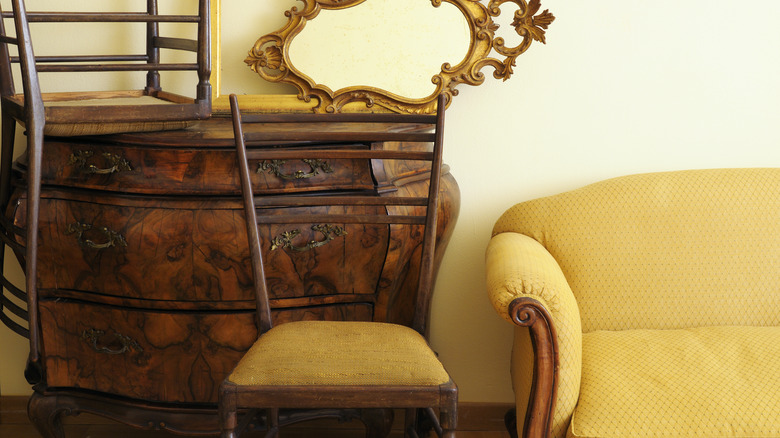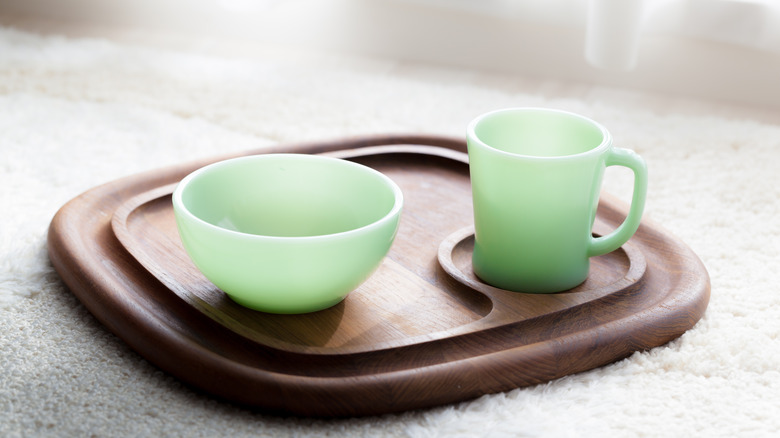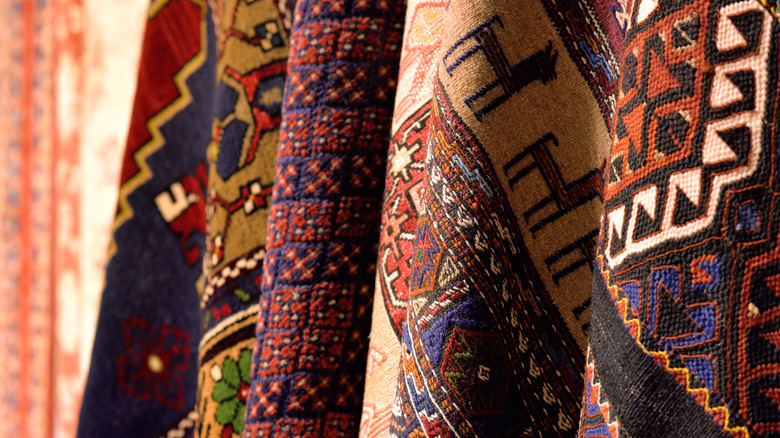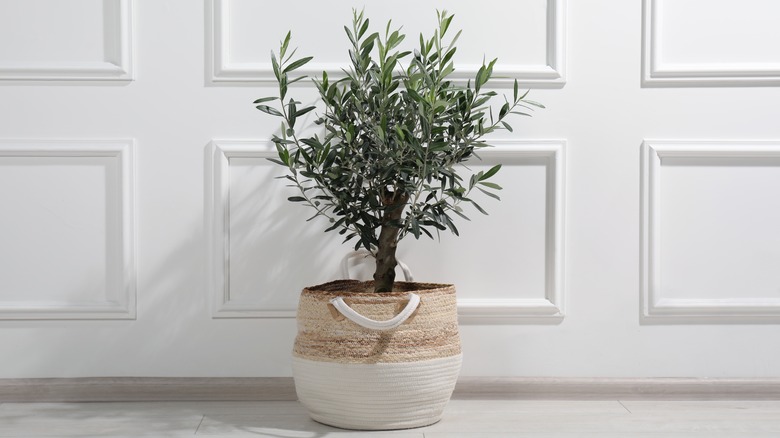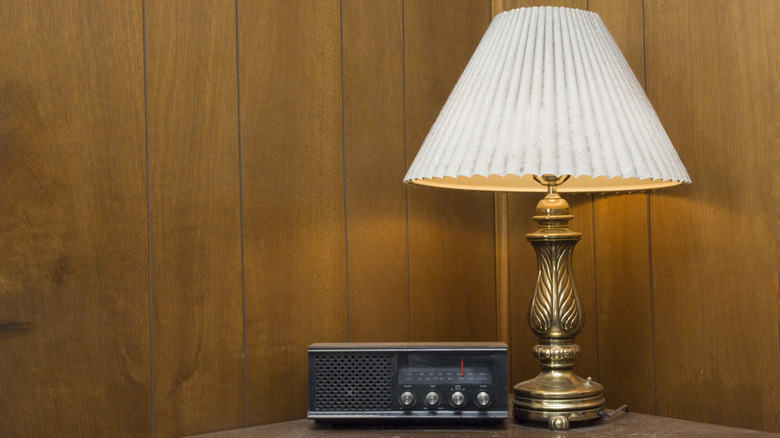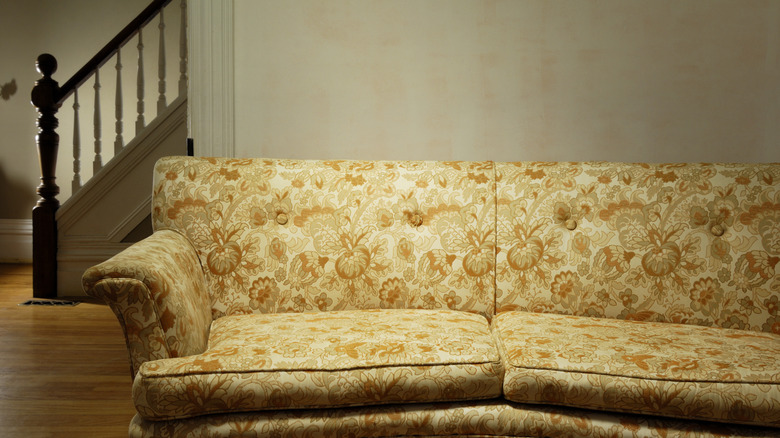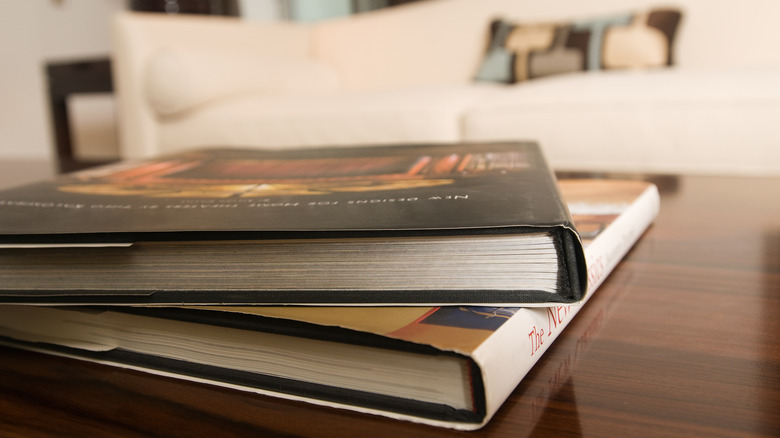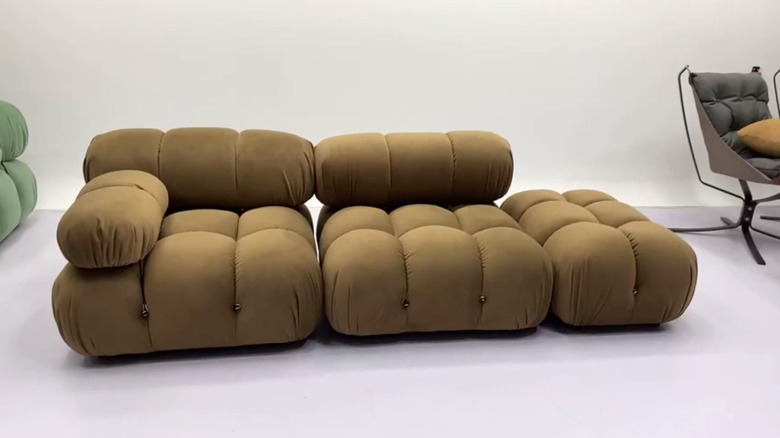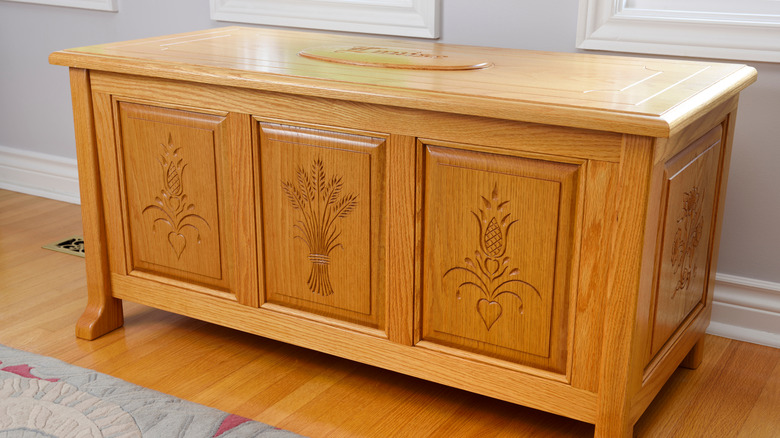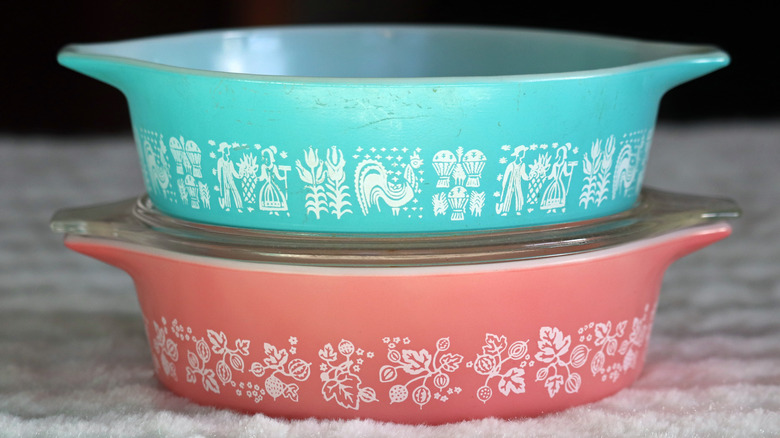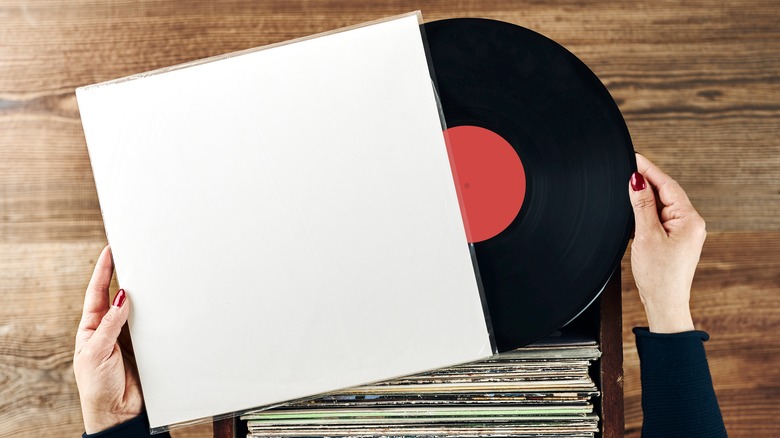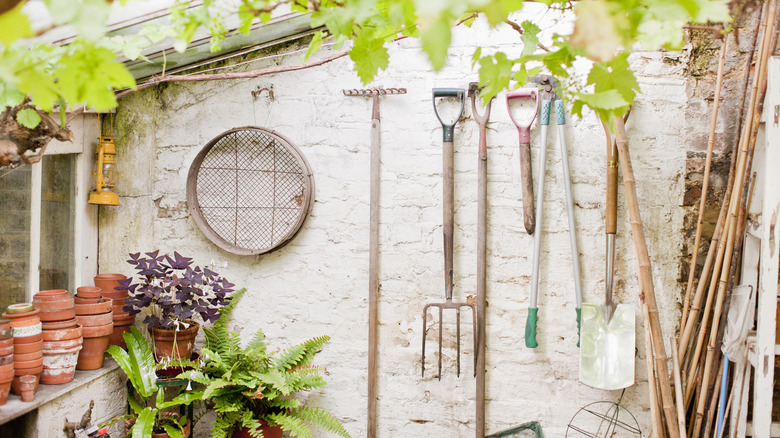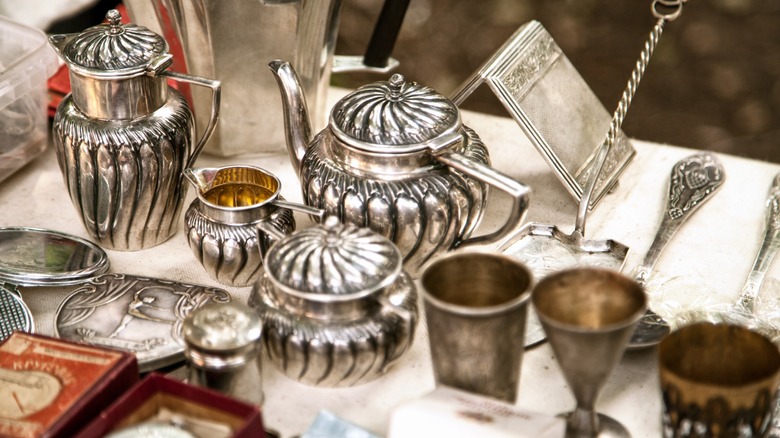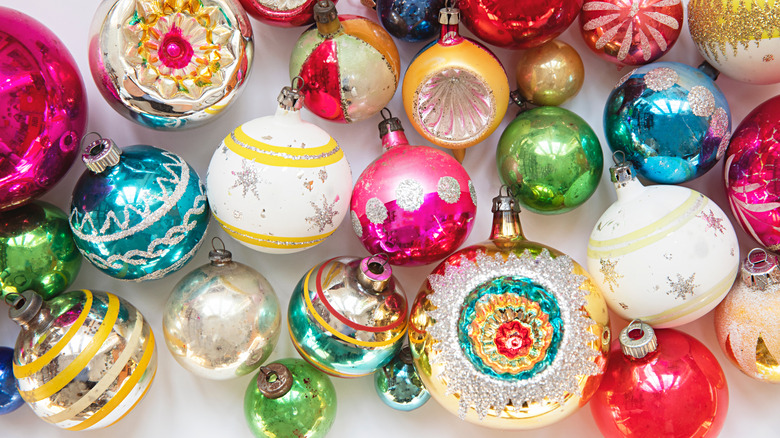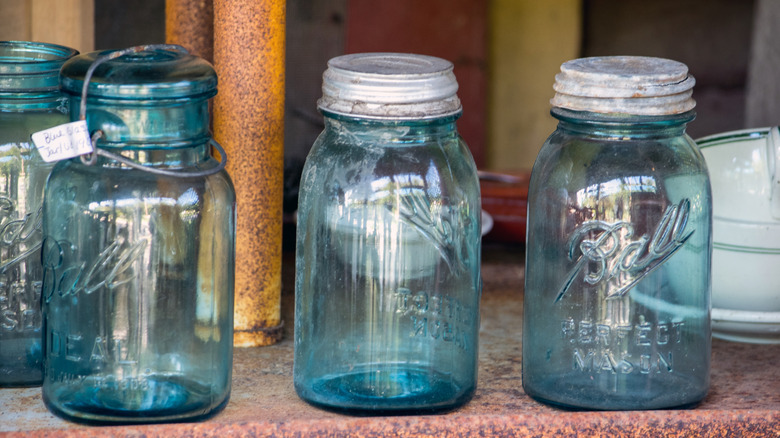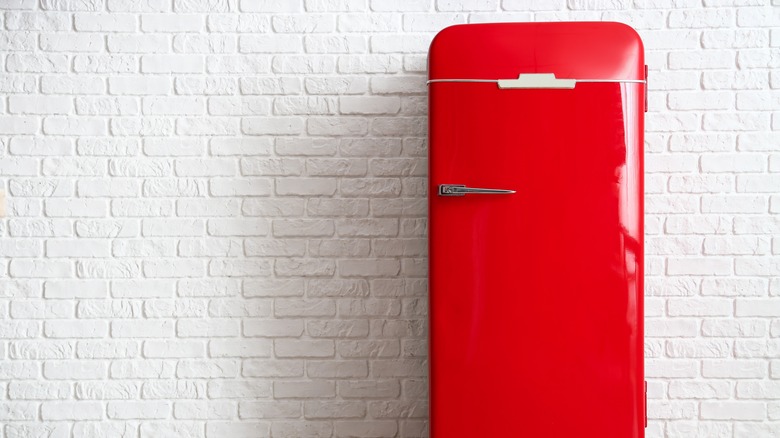The Most Valuable Things To Look Out For At Estate Sales
We may receive a commission on purchases made from links.
Have you been bitten by the estate sale bug? If you're into unique décor, curated design, or just downright good deals, estate sales can be a mine of exhilarating finds. Unlike a big box store, estate sales give you the chance to buy household items that very few other people have. You can come across high-quality goods that you'd usually have to pay a small fortune for and even stumble on holy-grail collectors' items. But mixed in with these exciting steals is also a lifetime's worth of bric-à-brac. Unless you want to steadily fill your home with incomplete board games and breadmakers that may or may not work, you'll need to practice discernment.
Attending estate sales can become addictive, and it's easy for bargain fever to gain hold. In the press of people, FOMO can set in fast, and before you know it, you're caught up in the frenzy — and not buying that old blender for $10 feels like the missed opportunity of a lifetime. Fortunately, there is a way to make sure you come away from estate sales with true treasures and firmly skip the items you'll end up sending to the trash. If you want to save big or buy some really precious pieces, don't move an inch. Here is the in-depth list of the most valuable things to watch out for at estate sales that you've been waiting for.
Always browse the art
Art helps to anchor spaces, create compelling focal points, inject personality, and tie colors together. But buying art from galleries can get expensive fast. If you want original, one-of-a-kind artwork, estate sales are where it's at. Unless the paintings are by famous artists, you should be able to pick them up for a comparative song. Always look for the artist's signature. Signatures indicate that the piece is original and can allow you to research the artist. If you can't make out the name and want to learn more, a quick Google Lens search can point you in the right direction.
If you want to save big, scope the joint for oil paintings. Oils are inherently more expensive than acrylic paintings and sketches, thanks to the skill required and the material costs. Oil paintings also tend to be rich in texture, which can help to break up the flatness of prints and framed photography.
If you're feeling unsure, test the waters with more neutral pieces that will easily play with the rest of your décor. If you want to make an impact, keep your eyes peeled for big, bright, bold, or unusual paintings. Also, remember that art can come in many forms. Carvings and sculptures can help dress up bookcases, credenzas, and empty corners. Tapestries, wall hangings, and hung carpets can add richness and texture.
Watch out for solid wood furniture
If there aren't too many contenders, you can find wood furniture for a steal at estate sales. If the previous owners are elderly, there's a good chance they purchased their pieces back when timber was cheap and furniture was built to last a lifetime. Most items produced before the 1950s were made from solid wood.
To make sure you aren't buying a potential problem, carefully scrutinize pieces for woodworm damage. Look inside cabinets and drawers, investigate the underside of tables, and cast a critical eye at the legs. If you see any telltale pin holes, stow your wallet and move on. If there are any defects with a piece, like loose legs, bad burn marks, or stuck drawers, consider the extra time and expense required for repairs. Will you be able to fix the item yourself, or will you need to send it to a carpenter?
To make sure you don't get swindled, check for signs of superior craftsmanship like hand carving, dovetail, dowel, and mortise and tenon joints. If you have your eye on a veneered item, inspect the edges. If the veneers are book-matched, you're probably looking at a high-quality piece. If you can find a maker's mark, you may have hit the vintage furniture jackpot. These inscriptions take the form of small plaques, engravings, or old labels discreetly placed inside drawers, on the back or underside, or on the bottom edge of a cabinet door. They usually include the name of the furniture firm or designer and its country of origin.
Estate sales are the perfect place to get pretty glassware
Colorful glasses and goblets are very much in vogue, but this charming trend is far from new. It's a resurgence of a massive moment in glassware that took off in the 1920s and 30s when manufacturers moved away from hand-blown glass and started producing molded items, which retailed for far less. This new, cheap glassware came as a small godsend. As Americans weathered one of the darkest economic periods in modern history, a colorful cup at an accessible price point presented a small sliver of joy. As if to intentionally brighten consumers' lives, producers churned out a medley of pastel tones in translucent and opaque glass.
Estate sales are the perfect place to pick up Depression glass. One way to spot an authentic piece is to look for seams and rough spots. To keep costs down, manufacturers didn't smooth down mold marks. Air bubbles, irregularities in colors, and flaws in the shape can also be telltale signs that you're holding a genuine piece of Depression glass.
If you prefer to keep color out of your glassware, don't fret, because there's a plethora of other vintage styles. Antique glassware will also often have small flaws, and you might even get lucky and find an engraved maker mark. If quality is your main priority, look for items that don't have obvious seams. For vases, look for ones that feel heavy in the hand. For wine and water glasses, look for clarity and comparative weight. If the glass feels somewhat heavy but is relatively thin, this is an indicator of strength. Be aware, a lot of antique and vintage glassware can contain lead. Fortunately, you can test your tableware finds with inexpensive lead detection swabs.
Well-looked-after vintage rugs can offer superb value for money
Buying someone else's old carpets might not be your initial idea of a good time, but a great rug at an estate sale can be a certified score. Rugs, in general, tend to be pricey pieces of home décor. But well-preserved, vintage ones can send you seeking money from your 401k. Fortunately, you don't have to make a fool of yourself over a carpet if you know how to spot a bargain. Any type of rug that's in good shape can be a solid buy as long as the price is right, but if you come across a handmade one, your luck is in.
Not sure how to identify a handmade carpet? Start by looking at the underside. You shouldn't see any plastic mesh backing, instead, you should be met with wool or cotton fibers. The pattern on the back should also closely resemble the front. Press open the fibers a little and look at the color distribution. It should be even up to the surface. If the weave is tight, this is a sign of quality. Artificially distressed rugs have become all the rage, so check closely to make sure you aren't dealing with a printed "vintage" rug. Printed rugs tend to have a very low pile, an entirely plain back, and exaggerated, washed-out-looking fading.
Part of the charm of vintage rugs is their imperfections and signs of age, but there is a limit to how worn you should go. Unless you're buying the rug for next to nothing, avoid ones that have very frayed edges or areas of foundation showing through the top. That said, you can get large rugs cut down, which can remedy worn edges and allow you to get rid of stained areas.
Mature potted plants can save you some serious cash
If you're a proud plant parent, you're probably all too aware of how costly mature specimens can be. If the owners of the estate happened have some sizable plants, these can present a serious steal, especially if they're housed in big pots. Large planters alone can run you over a hundred dollars, so if you see any empty pots, place your claim before a fellow shopper beats you to it. To make sure you're getting your money's worth, look for planters made out of clay or cement. Handmade clay pots (which normally can be very pricey) may even have a maker's mark on the bottom.
As for the plants themselves, a quick Google search should give you an idea of how much you'll save by buying "second-hand." For instance, a tall ficus tree in a 30-inch planter will probably cost you more than $400 at a nursery or plant center. It's unlikely a plant like this will go for the same price at an estate sale, but it probably won't look as fresh and perfect. A few dead leaves aren't a problem, but if you see any signs of mites, bugs, or blight, you should probably pass so as to prevent spreading disease to the rest of your collection.
Lamps and light fittings can also be a good find
If you're looking for some, ahem, lit light fixtures, estate sales are the place to be. Yes, you'll probably find a fair amount of corroded, questionable lights, but you can also come across stunning candelabras, good-quality chrome options, statement floor lamps, and more. If you see a relatively new lamp, you can easily compare prices online to see if it's a bargain. Researching prices for older light fittings is a little bit harder. Antique and vintage lights can list for anything from $30 to a hundred grand and over on marketplaces like 1stDibs. If you think you've stumbled upon a vintage or antique lamp, check the base for a maker's mark or date. You can also date light fittings by their style.
Another thing to look at is the cord and plug. Does the plug look a little strange? This could be a surefire sign you've come face-to-face with an antique. Plugs with identically sized prongs were the norm up to the mid-1900s, and it wasn't until 1962 that the polarized outlets we have today were stipulated by the NEC. Another not-so-subtle sign of an antique lamp is fabric or woven cotton surrounding the cord. If you had a penny-wise grandparent who was still using their iron from the 50s, this might ring a bell. Speaking of plugs and cords, keep in mind that most old light fittings will need to be rewired, even if they can fit a modern outlet, so you'll want to factor this expense into the total cost.
Finally, don't let shabby shades fool you. If a lamp has great bones, recovering the shade can be a cost-effective way to update it. It's also a great way to coordinate the lamp to the rest of your color palette for a custom look.
Don't disregard vintage sofas
You may be tempted to give vintage sofas the side eye, but great skeletons can lurk under dated upholstery. Yes, older settees aren't always the softest or the most cushy, but this might be something you're willing to compromise on if vintage décor is close to your heart. Reupholstering a vintage sofa can leave you with a one-of-a-kind, high-quality piece that's updated and fresh. You'll also get the opportunity to choose a color that's in perfect conversation with the other pieces in your space.
Besides reupholstering, you can also go a step further and refurbish the springs and breathe some (non-squeaky) bounce back into your vintage sofa. Old sofas aren't usually a hot ticket item unless they're in spotless condition or an obvious antique. If you're planning on refurbishing or reupholstering, see if you can negotiate the price down to help pay for the costs. And before you commit, do the sniff test. Deeply entrenched odors can be incredibly hard to get out of furniture, and you definitely don't want to bring a piece into your home that smells of tobacco smoke or puppy pee.
Estate sales are a great source for cool coffee table books
What better way to give your living room a cultured, grown-up vibe than with a few tastefully chosen coffee table books? There's just one problem. If you want more than one, even a meager pile can end up costing more than the coffee table they're resting on. If you don't want to blow a couple hundred dollars just to dress up your lounge with some reading material, estate sale books are a total boon. Depending on the previous owners' interests and tastes, you can pick up some real gems, filled with photography and illustrations that you won't find online.
And if you're assuming that second-hand coffee table literature is going to make your décor look dated and drab, think again. Vintage coffee table books have been picking up steam as a hot trend, visually driven by TikTok and emotionally fueled by nostalgia. Whether you enjoy trends or rail against them, going retro with your coffee table accoutrements is a whole lot more unique than resorting to a copy of the predictable, costly Tom Ford book.
Retro pieces from coveted designers can be worth a small fortune
Do you have your heart set on a retro design that's resurged in popularity? Like the trendy Toga seats with their striking silhouettes, chubby Pacha chairs, or bulbous Mario Bellini sofas? These and other interesting furniture designs have fast become internet famous as influencers fill their feeds with photos of funky retro pieces. Faux imitations abound, but if you want one of the originals, expect to part with some serious cash. For instance, a new, genuine Toga chair costs around $2,600, which is a staggering sum to pay for a single seat. Estate sales are one of the ways a regular person can own one of these pieces.
Finding a designer item of furniture that not everyone would have owned back in the day requires patience and luck. But here's an easy insider hack you can use to increase your chances of scoring that dream piece. Start by searching for it on Estatesales.net. If nothing comes up, set an alert. Any time something is listed with your specific search term, you will get an email.
Snag a cedar chest if it suits your design style
Cedar chests are another solid estate sale steal. Hope chests have a strong place in American history and were originally designed to house brides' trousseaus. Antique chests often sell for thousands on marketplaces like eBay, but with a bit of luck, you can still pick up these old-fashioned treasures for a relative song at estate sales. Because they have very few moving parts, are made of wood, and are sturdily constructed, there's usually very little wrong with these old chests.
Unless you're a modern-day puritan, you're probably not hoarding cheese graters and table linens for your betrothal. But this doesn't mean you can't take advantage of the extra storage space a hope chest holds. Cedar chests can do double duty as coffee tables, impromptu seats, side tables, and entryway benches while housing bulky items like throw blankets, board games, and winterwear. Vintage chests are particularly suited to traditional and transitional design styles, but they can also work beautifully in rustic, bohemian, and eclectic spaces.
Pyrex and Corningware casserole dishes have a certain amount of resale value
Gone are the days when grandma's old crockery was devoid of value. Vintage casserole dishes have quickly become collectors' items. One of the reasons is nostalgia. The other is practicality. Pyrex glass and ceramic CorningWare dishes don't just look cute; they're also (self-evidently) very long-lasting, and seriously anti-stick.
But before you pounce on every piece of Pyrex you see at an estate sale, there are a few caveats to be aware of. Like old glasses, vintage Pyrex and ceramic cookware can contain lead. If you're buying these dishes to cook with on the daily, it's definitely a good idea to test them for lead, and you might find that buying new Pyrex is sometimes a safer bet.
Of course, this doesn't mean you can't amass vintage cookware as a hobby or for its collectors' value, but be aware that resale prices aren't always as amazing as online articles make out. For instance, CorningWare casserole dishes are currently supposed to be one of the hottest types of 70s glass-ceramic, with some rare patterns allegedly selling for tens of thousands of dollars, according to MSN. In reality, even immaculate sets of sought-after patterns probably won't fetch more than a few hundred dollars.
Vintage vinyls can be very valuable
Do you love the sound of analog audio? The right estate sale can be a veritable treasure trove if you're looking for vinyl records. While CDs and cassettes dominated the 90s, vinyl sales plummeted. Fast forward to the 2010s, record sales have rebounded, and vintage vinyls are now a popular collectible.
But before you fill your arms with albums at an estate sale, take some time to check their condition. Carefully remove each record from its sleeve and scan it for scratches. Hold it up and make sure it's not warped or bent. If you can feel a scratch with your fingernail, you'll probably hear it too. If the record is very shiny, this can be a sign that it's been barely played, and you should probably snag it before someone else does. If you want to try and gauge a record's rough resale value, scrutinize the jacket and the LP label for information that will help you figure out the album release, such as the barcode or catalog number. If you run into records that aren't fit to play, you can also upcycle them into unique vinyl décor.
Grab great deals on tools and garden implements
If you're in the market for some tools, press pause on your trip to Home Depot, because you may be able to bag a total bargain at the next estate sale you visit. Second-hand tools and garden implements typically don't fetch a high price. While you'll probably pay 40 bucks for a new spade, you could pay pennies on the dime for the same thing at an estate sale. Granted, it might not be brand new, but this doesn't really matter when it comes to solid implements like shovels. Screwdrivers, hammers, rakes, forks, hatchets –- most of these items are virtually indestructible. You might even find a good deal on power tools if they've been recently purchased, but don't pay too much because you won't be getting a warranty.
If you buy a really old manual tool, it might even have some numismatic value. As we race towards the quarter-century mark, even tools have started to become collectibles. Certain types of antique planes have sold for thousands on auction. So you might want to research your finds a little before you put them to work in a DIY project.
Solid silver items can sometimes be underpriced
Before opening homes to the public, estate liquidation companies evaluate the contents. Highly valuable items are often sold separately, prior to the actual estate sale. The ones that remain are invariably snapped up by eagle-eyed experts and pickers who get the privilege of first admission. By the time regular folks look over the home, anything big that's made out of precious metals has probably left the building. But just because there isn't much chance of finding a solid silver candelabra doesn't mean you can't still snag some small items for a steal.
The trick to finding a silver treasure? Trawl the junk piles. Anything that's prominently and neatly displayed is probably not going to be underpriced. But disheveled drawers of kitchenware could be hiding well-used silver cake servers, small forks, serving spoons, etc. Keep your eyes peeled for small shiny items mixed in with the bric-à-brac. A complete set of solid silver tableware that's kept in a case isn't likely to escape the eyes of experts, but a gold cigarette case, pen, or flint lighter could fall through the cracks. Also be on the lookout for anything tarnished. A green-tinged tray tossed together with scratched chopping boards could turn out to be a valuable silver item. Small odds and ends of jewelry mixed in with low-value trinkets might also pass under the radar of collectors.
Antique Christmas decorations can command a small fortune
Old Christmas decorations might not be the first thing that comes to mind when tracking down valuable treasures at an estate sale. Modern Christmas ornaments don't have much of a resale market, but it turns out that certain antique baubles can be relatively valuable. German Kugels are some of the most sought-after. These antique globes are the OG of Christmas ornaments. Handblown in Germany, Kugels quickly became a must-have holiday ornament throughout Europe, partly thanks to the likes of Prince Albert and Queen Victoria (the original influencers, it seems). Some of these decorations made their way over with the early settlers and became particularly concentrated in areas with a high German-American population, like Pennsylvania. Made out of glass, these charming ornaments have a reflective colored film inside and a brass attachment point at the top.
German Kugels can sell for between $100 and $200 per ornament. But resale values can vary widely and depend a lot on the condition, color, and shape of the bauble. Round, silver Kugel globes are the most common. Certain colors are highly sought after, like black and muted tones of green, light blue, and bronze. Grape-shaped Kugels tend to be rarer and more valuable than globes, as well as the very scarce pinecones, berry bunches, and artichoke shapes. Even if you're not particularly interested in the resale value, adding a few of these antique finds to your Christmas décor will imbue your tree with a touch of historical charm and help you decorate for the holidays on a budget.
Old Mason jars might be worth much more than meets the eye
Mason jar home décor has been having a huge moment over the last few years, but did you know that these humble canisters can also be worth some money? You can find Mason jars a dime a dozen at thrift stores, but most of them mightn't be all that old and don't have any resale value. Antique Mason jars are a different story, and estate sales can be a great place to find them, especially if the family had a large home and a tendency to hold onto things.
Most antique Mason jars aren't worth a crazy amount of cash. Even very old, relatively rare jars don't usually sell for more than $300. The majority of obviously old specimens are probably worth between $20 and $50. But if you stumble on a whole box, this can still add up to a valuable find. One of the easiest ways to ascertain the jars' age is by inspecting the logo. The Mason and Ball branding went through a few different iterations over the decades. As improvements were made to the jars and their seals, the company also added adjectives, including "Improved," "Special," and "Perfect." These are the older models of Mason jars that were produced between 1858 and 1960. Even though you can make money on antique Mason jars, you also don't have to be a flipper to find value in rare, vintage versions. If you love farmhouse or shabby chic design, what could be more perfect than an antique Mason jar as an ornament?
Vintage kitchen appliances are becoming super sought-after
Are you starting to get the feeling that everything that was once outdated is now a cool collectible? Well, you're not far wrong. Even old kitchen appliances are coming into vogue. Companies have been releasing retro lines of fridges, toasters, and kettles to feed the hype. But these appliances are often priced high and made to profit from a trend rather than stand the test of time. Vintage appliances can be even more expensive, sometimes selling for a few thousand dollars. But if you're lucky, buying an antique appliance at an estate sale could allow you to make a big design statement on a small budget.
Old appliances aren't always hot ticket items, and a lot of people shy away from them in fear of hard-to-fix faults. Anytime you buy a second-hand appliance, you run the risk of it not working, but true vintage models might not be as risky as you think, as most were built to last. For instance, those pretty pastel fridges from the 1950s can be surprisingly robust thanks to their porcelain finishes and copper tubing.
Of course, before you hand over your credit card, you should always try to verify that the item works. If you're forced to take the estate sale company's word for it, try to bargain them down, because you'll need to get it professionally checked over. For most electrical appliances, you'll also have to get them refurbished and brought up to code, which will add to the cost. Even if they're immaculate, you'll need to (at the very least) get any cords and gas lines replaced.
